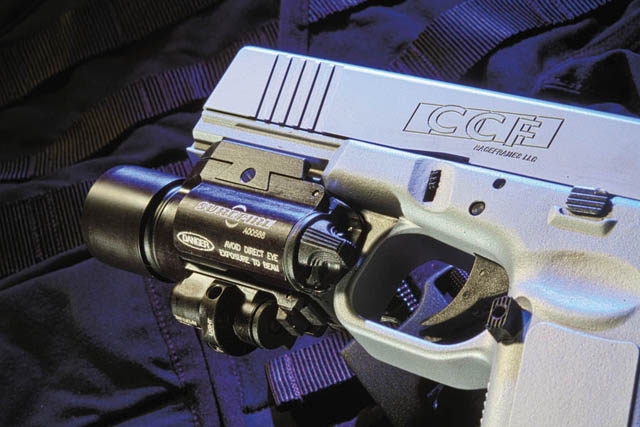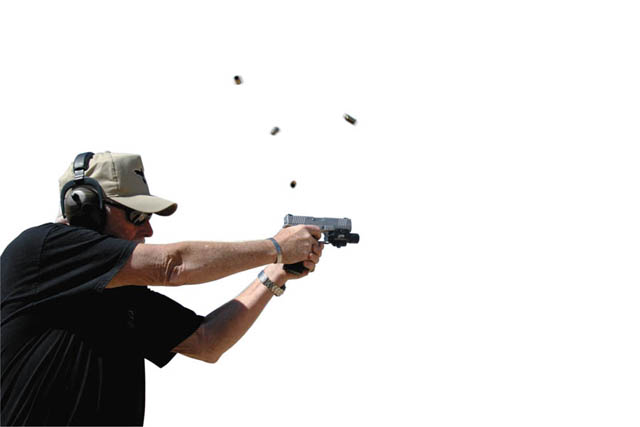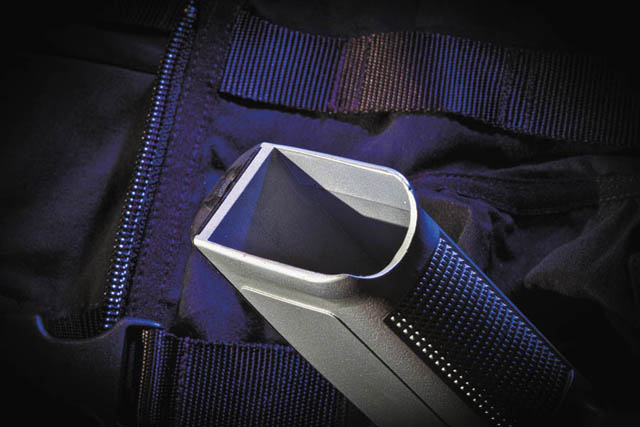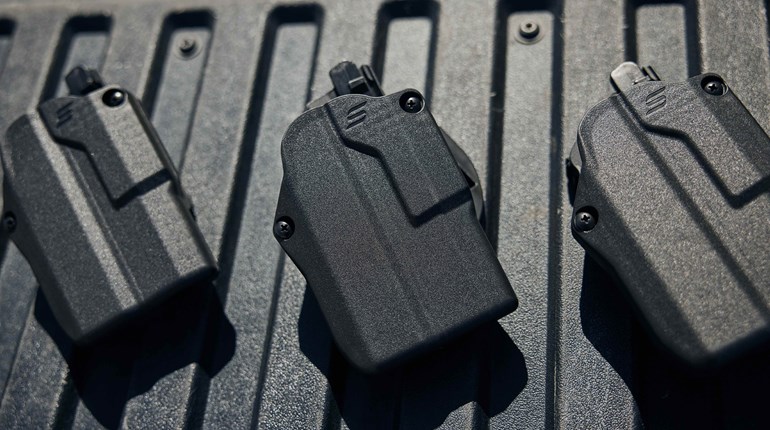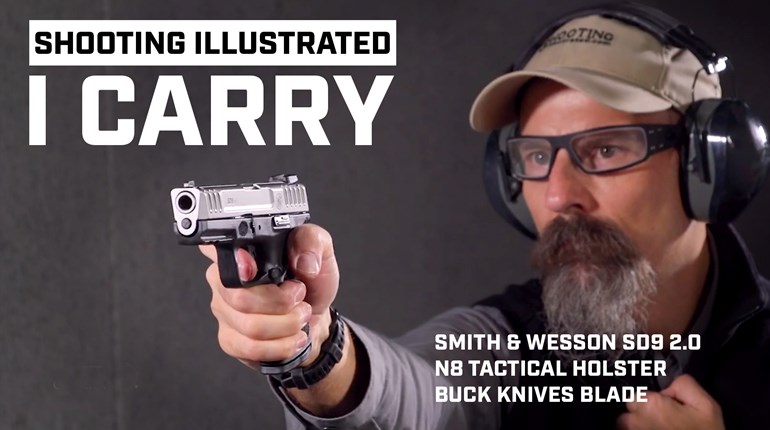
Where firearms are the issue, we continue to be amazed at the technical, design and production breakthroughs that emerge at an ever-increasing pace. One of these is the use of polymers in firearms. First it was grips, then small parts and finally frames.
When the Glock 17 emerged 29 years ago, it rocked the firearms industry. The Glock has always been an impressive pistol and has taken simplicity and reliability to new levels, at least in its 9 mm platform. I bought my first Glock 17 in the early 1980s. Both my wife (also a police officer) and I carried and shot it for many years. Since then, I have owned and tested a couple dozen Glocks (factory and custom) and have had great results from them.This being said, I still find problems with the Glock. For 99.999 percent of those I have instructed in the use of the Glock, it points high. OK, here's the drill: Hold the Glock in a close-in, low ready or whatever ready hold you prefer. Now look at the target, close your eyes and bring the pistol up to eye level. Tell me your front sight is not at least one degree higher than your rear sight. Is it more like two degrees? Is this a problem? It's your call.
Realizing the Glock is a true 21st century personal-protection handgun, Larry Gaglio, of CCF RaceFrames decided to take the bull by the horns and create an improved clone of the pistol. Recruiting the critical design talent in the aerospace, casting and firearms industries, Gaglio saw a number of areas for improvement in the Glock, with emphasis on the frame. He began with the Glock 17 and 22, which use essentially the same frame, and the Glock 17L, 24, 31, 34, 35 and 37 pistols.
Metal—What an Idea!
The CCF RaceFrame is made of metal, not polymer, and two kinds of metal were chosen—aircraft-grade aluminum alloy and stainless steel. While firearm designers have proven much can be done using polymer, CCF was well aware that the latest capabilities in investment casting and precision machining also amount to a quantum leap in what can be done with metal. The resulting improvements in the CCF RaceFrame are far more than a few.
Improved ergonomics are immediately noticeable. The beavertail-type tang of the new CCF RaceFrame is upswept to allow your hand to get on the pistol faster in the holster and to protect big hands from slide bite. It is also undercut to let the pistol sit lower in your hand. An increase in the frontstrap undercut is done for the same reason, and this high-cut feature also eliminates painful pressure to the middle-finger-joint of the strong hand. A relieved area around the magazine release provides the access of an extended release without potential drawbacks like the part being accidentally depressed.
Another welcome change is the absence of the squared trigger guard. Moreover, the bottom of the trigger guard is smooth, as is the inside surface, to eliminate fingers rubbed sore from lots of practice. The relieved inside of the trigger guard is also a valuable enhancement. With the CCF RaceFrame, one-size-fits-none finger grooves on the frontstrap are replaced by deep checkering for more positive purchase with hands of any size.
The frame's thumbrests are shallower than those on the polymer frame, and they include a 1911A1-type forward relief to strengthen your natural grip. It provides improved trigger reach due to better ergonomics. In fact, several law enforcement agencies are evaluating the CCF RaceFrame as a possible solution to issues stemming from compliance with the Americans with Disabilities Act for officers having difficulty qualifying with a Glock due to its grip size and trigger reach.
The CCF RaceFrame's beveled magazine well entry is slightly enlarged and the magazine well itself has a straight taper—eliminating the hourglass shape found inside the polymer frame from shrinkage during the injection molding process, which tends to grab the magazine. This improvement helps magazines insert and drop more smoothly.
Match-grade accuracy has been achieved with CCF RaceFrames' super-tough, machined locking block, which is supplied with the frame. Pinholes are put into the locking block and frame at the same time. This block also significantly improves lockup, which enhances accuracy.
Reduced felt recoil is accomplished not only by improved ergonomics, but also by the CCF RaceFrame's lower bore-to-hand relationship and increased weight. With the components housed in rigid metal, the trigger-reset distance is reduced and is more positive. Trigger pull is not only improved, but is also consistently crisp, eliminating the polymer unit's spongy feel and overtravel.
A Longer Frame Rail
Integral with the dustcover portion of the frame is a 1913-style rail. Unlike the rails found on virtually all polymer frames, this version will accommodate more accessories. The CCF RaceFrame's rail is friendly to virtually all tactical weaponlights, lasers and beyond.
As for natural pointing, the frame is available with two interchangeable backstrap inserts. Made of soft black polymer—the only polymer things on this frame—these backstraps attach to a vertical dovetail and lock via a crosspin. One of these backstraps duplicates the factory Glock grip angle. The other is flatter, resulting in the pistol pointing more naturally for the vast majority of users and mimicking the grip angle and feel of a 1911. TheCCF RaceFrame and Enhanced Slide accept all Glock factory parts—with no fitting required.
A Custom CCF RaceFrame Pistol
As fascinating as this state-of-the-art frame is for use with a Glock factory slide group, I wanted to try one on a fully custom pistol. CCF also makes its own Enhanced Slide, so I obtained a stainless steel variant of it and the frame and sent them to one of the best custom Glock gunsmiths in the world, John Nagel of S & J Customs. Nagel not only builds custom Glocks for most of the top competitors in America, he also builds the custom pistols for the Glock team. However, it wasn't a competition pistol that interested me, but rather one designed for uniformed duty, so I chose a test sample in 9 mm.
The CCF RaceFrames Enhanced Slide comes with angled cocking grooves at both the front and back that are functional and attractive. The front grooves are useful for the preferred method of press checking for a round in the chamber.
Other than a CCF RaceFrames chassis and slide, the only other things I insisted be installed on the pistol was Novak's 18-karat gold bead combat front sight and the rear sight I designed in 1994, also made by Novak's. Called the Ghost Sight, it amounts to a Novak LoMount Sight with a semi-circle instead of a square notch. The roughly 9 mm cut of the Ghost Sight allows plenty of light on each side of the front bead in order to see more of what's going on—whether shooting the pistol or giving commands to a suspect. With this sight, however, it is more difficult to lose your front sight when you and your adversary are moving. The Ghost Sight also works far better for me when shooting moving steel targets.
Nagel had never built a duty-type pistol before and was looking forward to the challenge. He wasn't sold on the Ghost Sight, but agreed to install it. After Novak's sent the sights, Nagel called to tell me how much he liked the Ghost Sight, and that he could see the advantage it offered in a fight. I told him it worked just as well for me at 50 yards and beyond as a standard notch.
Once everything was ready, Nagel had the stainless CCF RaceFrame, slide and a new Glock 17 barrel hard-chrome plated. He then performed the final assembly and test fired the gun to sight it in and verify accuracy requirements. A 2.5-pound trigger was added. He also installed a magazine well funnel and an extended magazine-release button. When the pistol arrived, it was everything I anticipated. However, while the mag well would be fine for a uniform duty pistol, my gun would be carried concealed, so I eventually removed it, as well as the extended magazine release to prevent unintentionally dropping the magazine when carrying the gun close to my body.
Two Frame Choices
Although CCF RaceFrames anticipated the aircraft-aluminum alloy frame would be the most popular, requests for the stainless steel frame have been 10 to one. The aluminum alloy with its hard-anodized gray finish is great where weight is a prime concern, but the additional heft of the matte-finished stainless steel frame is what everyone seems to want. The alloy frame weighs only 3 ounces more than the Glock factory frame, while the stainless steel version weighs 16 ounces more. Indeed, with the flat backstrap, this version feels almost exactly like a 1911.
Holster Friendly
While the CCF RaceFrame improves the Glock's performance immensely, it does not affect the pistol's abililty to fit in Glock-size holsters, apart from some using a locking hood, which may interfere with the pistol's extended tang. All other points used by any holster to secure the pistol are preserved. If your full-sized Glock works in it, so will one converted with a CCF RaceFrame. My new pistol worked perfectly in a Blackhawk Serpa rig and also in a couple of great new concealed-carry holsters from Richie Leather Company.
Down Range
The handling of the CCF RaceFrame is superb. Trigger let-off seems improved by about 300 percent and operation is as smooth as silk. It fits perfectly in the hand and points naturally with the sights aligned on target when raised to eye level.
After each round of even the hottest 9 mm load, the pistol stays put and recovery time is almost instant because the gun comes back on target due to its increased weight. As with the many Glocks I have fired, malfunctions are nonexistent.
In speed drills on a steel reactive hostage target, the sights came back on target as 147-grain bullets slammed into the hostage-taker portion. With a standard Glock 17 barrel in my CCF RaceFrames pistol, I had little trouble hitting head-sized rocks when standing using a two-hand hold at 100 yards. At 25 yards, the pistol produced five-shot groups in the 2- to 3-inch range, handheld—roughly 1⁄3 tighter from the bench. At 50 yards off the bench using a variety of factory 9 mm ammunition including match-grade selections from Atlanta Ammunition it produced groups in the 3-inch neighborhood. I had not heard of this company until Nagel recommended it, but it makes top-notch competition and duty ammunition in most calibers.
S&J Customs Pistols
Along with my custom CCF RaceFrames pistol, Nagel sent three of his personal S&J Customs competition pistols: one long-slide in .40 S&W and two custom Glocks in 9 mm. One of the 9 mms was designed for open competition for use with special ammunition, samples of which were also included. I've never played with any competition pistols that surpassed these and I hated to say goodbye to them, but being a concealed-carry guy I'm thrilled with my combat-oriented Nagel custom CCF RaceFrames Glock.
By the way, don't let anyone tell you the 9 mm won't do the job. The 1970s were a long time ago, and the 9 mm partook of the same quantum leap in bullet design as .40- and .45-caliber bullets in the early '90s. Today the three of them are pretty close together in performance, but that's fodder for another article.
Those who carry a Glock 17, 22 or similar-size models will be impressed with the outstanding quality and improvements either of the metal CCF RaceFrames brings to the table—not to mention the superb work performed by S&J Customs. Contact CCF RaceFrames: (804) 622-4277; and S&J Customs: (770) 402-1290.
